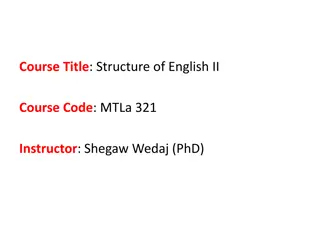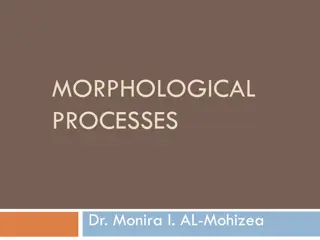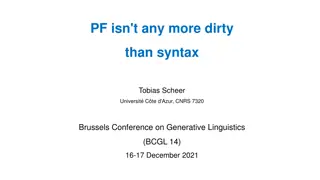Morphological Operations in Computational Linguistics
Explore different morphological operations in computational linguistics, including phonological changes induced by affixation in German, subsegmental morphology in Irish, and subtractive morphology in Koasati. Transducers and examples are provided to illustrate the transformations involved in each process.
Download Presentation

Please find below an Image/Link to download the presentation.
The content on the website is provided AS IS for your information and personal use only. It may not be sold, licensed, or shared on other websites without obtaining consent from the author.If you encounter any issues during the download, it is possible that the publisher has removed the file from their server.
You are allowed to download the files provided on this website for personal or commercial use, subject to the condition that they are used lawfully. All files are the property of their respective owners.
The content on the website is provided AS IS for your information and personal use only. It may not be sold, licensed, or shared on other websites without obtaining consent from the author.
E N D
Presentation Transcript
21.05.14 Computational Morphology Morphological Operations II Lecturer: Yulia Zinova Date: 21.05.2014
21.05.14 Literature Roark, B. and Sproat, R., 2007. Computational Approach to Morphology and Syntax. New York, NY: Oxford University Press.
21.05.14 Phonological changes induced by affixation Example 1: suffix chen in German. The suffix induces umlaut on the vowel of the stem to which it attaches. Given the transducer Tumlthat changes the vowels into their umlauted forms, the entry for chen is as follows: X =Tuml[ :chen] Some examples: Tochter- T chterchen Maus - M uschen Kommode - Komm dchen
21.05.14 Phonological changes induced by affixation Transducer Tuml(reversed order): Id( ) Id( ) a: | o: u: a:u a | a:u
21.05.14 Subsegmental morphology Morphological alternans can also be indicated with subsegmental information, such as change of a single feature. Example 2: genitive formation in Irish, where the genitive is marked by palatalizing the final consonant (sequence) of the base (nominative) stem: Nominative Genitive Translation b d /d/ b id /dy/ boat eolas /s/ eolais / / knowledge sagart /rt/ sagairt /ryty/ priest
21.05.14 Subsegmental morphology Possible transducers for example 2: C( s):Cy | s: V:iV Reversed order Id( ) V:iV s: Normal order Id( ) C( s):Cy
21.05.14 Subtractive morphology An example (example 3) for subtractive morphology (also: truncation) is the plural stem formation in Koasati. The final rime of the singular stem (consisting of a final vowel and any following consonant) is deleted in the formation of the plural sten. The onset of the final syllable of the singular stem is retained. In our example we only consider phonological forms: Singular Plural [+pl] pit f-li-n lat f-ka-n tiw p-li-n atak a-li-n iyyakoh p-ka-n p t-li-n lat-ka-n tiw-li-n at k-li-n iyyak f-ka-n
21.05.14 Subtractive morphology Transducers for example 3: VV: | VC: li:li | ka:ka n:n Id( ) V: V:V C:C :[+pl] V: C: :[+pl]
21.05.14 Extrametrical infixation An example (example 4) for extrametrical infication can be found in Bontoc. The infix um marks different semantic infromation. The infix is prefixed to the word, ignoring the first consonant, if any: antj ak k w sat umantj ak kum w sat We will build two transducers first one (T1)will insert a marker > (note that > ) in the appropriate location in the word, the second one (T2) will convert the marker to the infix um and add a morphosyntactic feature [+be] marking the construction at the end of the word.
21.05.14 Extrametrical infixation The two transducers for example 4: : > V: V : T1 C: C : > : > : um T2 :+be
21.05.14 Positively circumscribed infixation An example (example 5) of infixation that attaches to prosodically defined portion of the base is the language Ulwa. The prosodic unit is a iambic foot. The infixes (personal possessive markers in Ulwa) suffix to the first foot of the word. Initial form Translation With possessive marker bilmaki Translation bilam fish my fish dii snake diimamuih your (sg.) snake liima lemon liikama his lemon sikbilh horsefly siknibilh our (incl.) horsefly onyan onion onkinayan our (excl.) onion mistu cat miskanatu their cat anaalaka chin anaakanalaka their chin
21.05.14 Positively circumscribed infixation In example 5 the iambic feet include disyllables with a short vowel followed by either a long or short vowel (bilam, anaa), and monosyllables with either a long vowel (dii) or closed syllable with VC (sik). If the word is a single foot (bilam, dii) the affix is merely a suffix, otherwise the affix attaches to the first foot (as in liima). Using the marker > we can define the following strings: for single foot: C?(VC|VV|VVC|VCVV?C)> for others: C?(VC|VV|VCVV?)>CV























